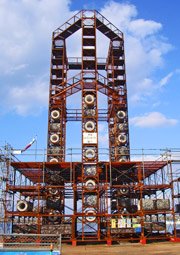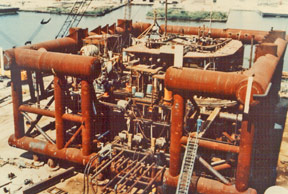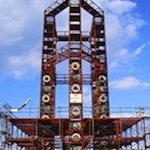Artificial Reefs Made from Steel:
Potential Benefits and Issues
What does a trade-off analysis reveal?
 Artificial reefs made from steel materials are becoming increasingly popular among American and other reefs builders as artificial reef construction expands worldwide.
Artificial reefs made from steel materials are becoming increasingly popular among American and other reefs builders as artificial reef construction expands worldwide.
In East Asia, most steel artificial reefs are designed and fabricated specifically for commercial fishery development.
In contrast, most steel reefs here in the U.S. are built from “opportunity” material. These material include decommissioned vessels, petroleum platforms, military armored vehicles, subways cars, bridges, and various types of steel demolition rubble.
Although repurposing this steel into reefs may enhance fishing and diving, tradeoffs between using the steel for artificial reef construction rather than pursuing other disposal options should be evaluated.
Let’s take a quick look at just three of these tradeoffs:
- Emerging environmental issues linked to some reused steel materials
- Dramatic changes in the price for scrap steel
- Total ecological impacts associated with not recycling steel
Emerging environmental issues
Emerging environmental issues are often related to contaminants associated with the materials or fouling communities on in-water materials such as vessels and petroleum platforms.
 In response, requirements for more extensive removal of contaminants, particularly PCBs and asbestos, have recently been passed – and that’s a good thing for the environment.
In response, requirements for more extensive removal of contaminants, particularly PCBs and asbestos, have recently been passed – and that’s a good thing for the environment.
But more extensive removal requirements mean dramatic cost increases associated with construction artificial reefs from steel MARAD and Navy vessels.
In addition, requiring removal of fouling communities to prevent the introduction of invasive species – also a smart move – means that dry-dock facilities, increasing costs even more.
Removing the fouling community then exposes contaminant-filled hull paint, creating further problems. And in more recent vintage armored vehicles with Chemical Agent Resistant Coating (a special paint with several potentially problem compounds), similar issues arise.
Scrap steel price changes
Prices for scrap steel have varied significantly in the past few years, at times making recycling a more attractive option for some steel materials, especially large MARAD or Navy vessels and armored vehicles (tanks).
These are government assets – so recovery of scrap value is a growing consideration with accountability to taxpayers at stake.
Ecological costs associated with not recycling
If we don’t recycle this steel, what are the environmental and natural resource impacts from the mining and smelting needed to produce more steel?
Should these costs be included in the decisions to create reefs with obsolete steel materials?
What should be evaluated?
With these issues in mind, evaluations about whether to reef or recycle obsolete steel materials need to be comprehensive.
At a minimum, organizations considering whether to construct artificial reefs made from steel should evaluate all current costs and benefits before making a decision. Some environmental benefits of using recycled steel instead of virgin ore to make new steel include:
74% Savings in energy
90% Savings in virgin material use
86% Reduction in air pollution
40% Reduction in water use
76% Reduction in water pollution
97% Reduction in mining wastes
 The appeal of seemingly cost-free donated materials may drive some decisions about reef materials, while other decisions are made on an ad hoc basis without looking at the true costs and benefits.
The appeal of seemingly cost-free donated materials may drive some decisions about reef materials, while other decisions are made on an ad hoc basis without looking at the true costs and benefits.
But with world-wide changes in commodity prices and growing concern about how our decisions impact the global environment, now may be the time to revisit the reef material selection process by applying a more comprehensive approach to evaluating environmental impacts, estimating scrap value based on current and projected prices, and performing total ecological life-cycle cost analyses.
Return to Aquabio Home Page from Artificial Reefs Made from Steel

